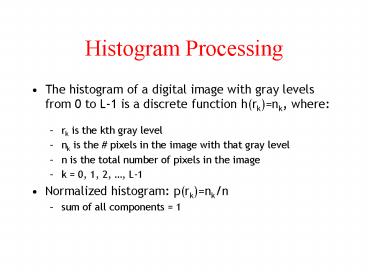Histogram Processing - PowerPoint PPT Presentation
1 / 12
Title:
Histogram Processing
Description:
rk is the kth gray level. nk is the # pixels in the image with that gray level ... to image enhancement lies in being able to construct a meaningful histogram. ... – PowerPoint PPT presentation
Number of Views:719
Avg rating:3.0/5.0
Title: Histogram Processing
1
Histogram Processing
- The histogram of a digital image with gray levels
from 0 to L-1 is a discrete function h(rk)nk,
where - rk is the kth gray level
- nk is the pixels in the image with that gray
level - n is the total number of pixels in the image
- k 0, 1, 2, , L-1
- Normalized histogram p(rk)nk/n
- sum of all components 1
2
Image Enhancement in the Spatial Domain
3
Histogram Processing
- The shape of the histogram of an image does
provide useful info about the possibility for
contrast enhancement. - Types of processing
- Histogram equalization
- Histogram matching (specification)
- Local enhancement
4
Histogram Equalization
- As mentioned above, for gray levels that take on
discrete values, we deal with probabilities - pr(rk)nk/n, k0,1,.., L-1
- The plot of pr(rk) versus rk is called a
histogram and the technique used for obtaining a
uniform histogram is known as histogram
equalization (or histogram linearization).
5
Histogram Equalization
- Histogram equalization(HE) results are similar to
contrast stretching but offer the advantage of
full automation, since HE automatically
determines a transformation function to produce a
new image with a uniform histogram.
6
(No Transcript)
7
Histogram Matching (or Specification)
- Histogram equalization does not allow interactive
image enhancement and generates only one result
an approximation to a uniform histogram. - Sometimes though, we need to be able to specify
particular histogram shapes capable of
highlighting certain gray-level ranges.
8
Histogram Specification
- The procedure for histogram-specification based
enhancement is - Equalize the levels of the original image using
n total number of pixels, nj number of pixels
with gray level rj, L number of discrete gray
levels
9
Histogram Specification
- Specify the desired density function and obtain
the transformation function G(z)
pz specified desirable PDF for output
- Apply the inverse transformation function
zG-1(s) to the levels obtained in step 1.
10
Histogram Specification
- The new, processed version of the original image
consists of gray levels characterized by the
specified density pz(z).
In essence
11
Histogram Specification
- The principal difficulty in applying the
histogram specification method to image
enhancement lies in being able to construct a
meaningful histogram. So
12
Histogram Specification
- Either a particular probability density function
(such as a Gaussian density) is specified and
then a histogram is formed by digitizing the
given function, - Or a histogram shape is specified on a graphic
device and then is fed into the processor
executing the histogram specification algorithm.































